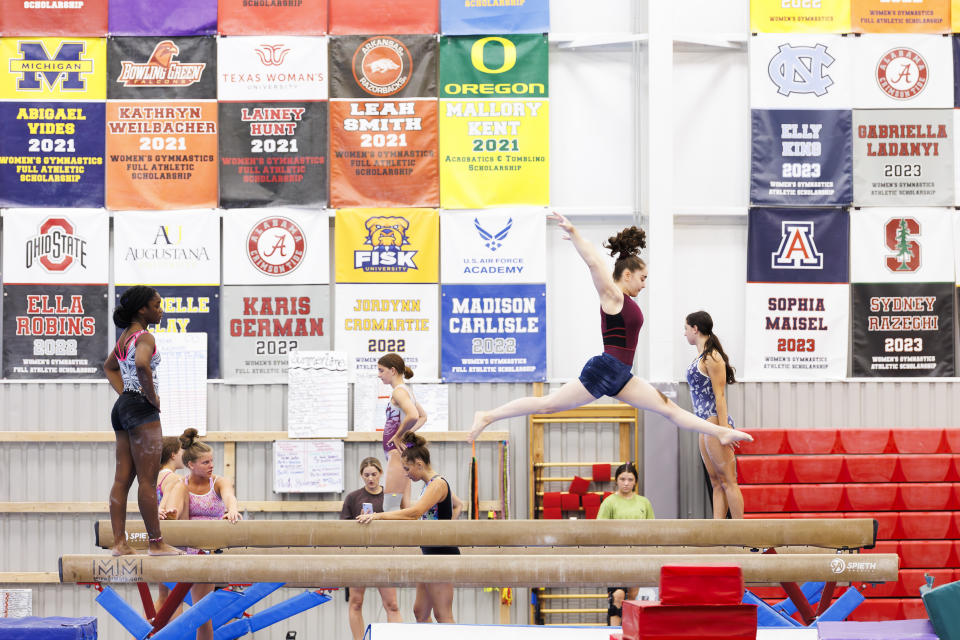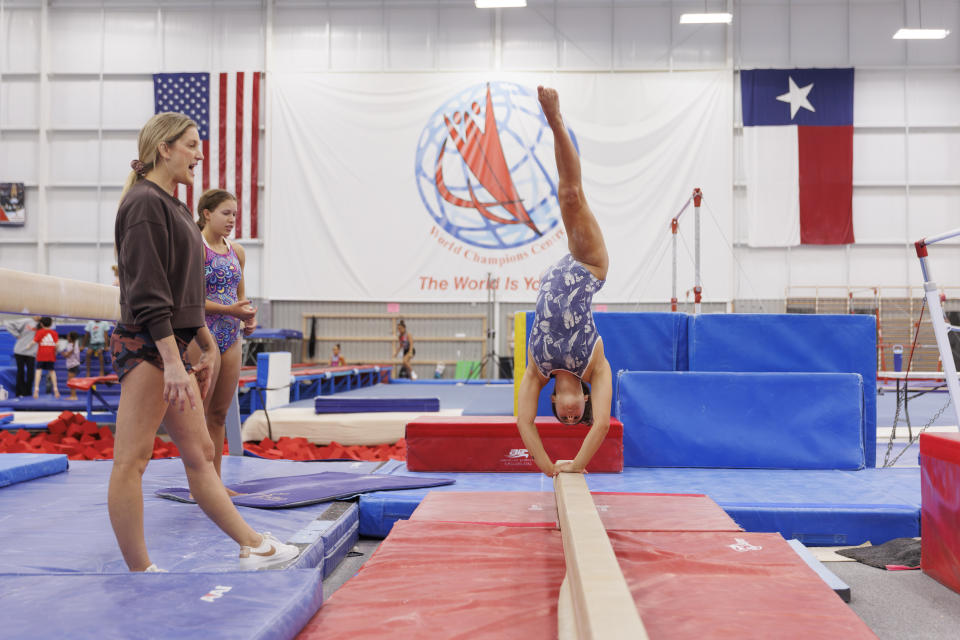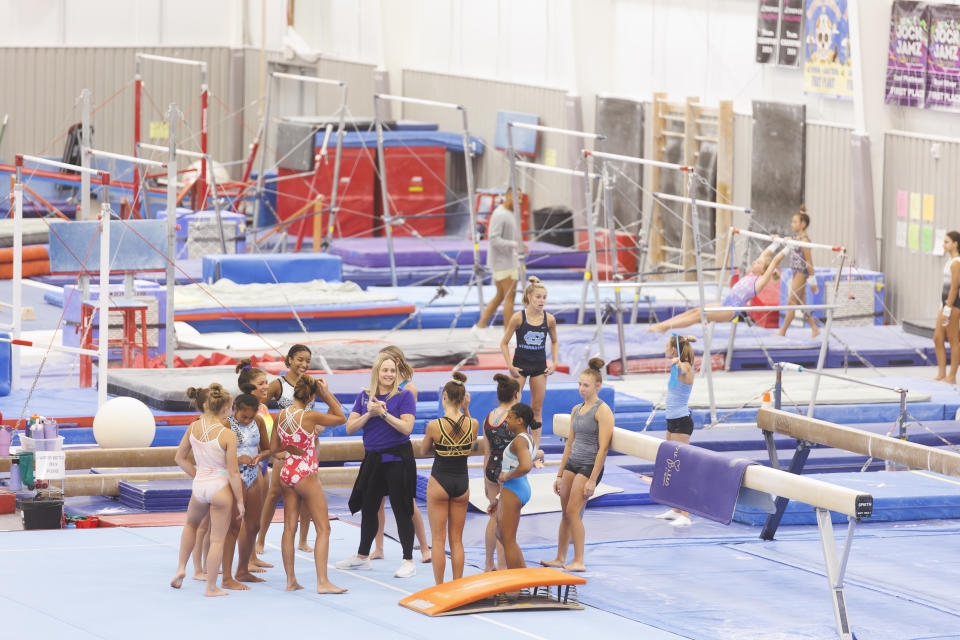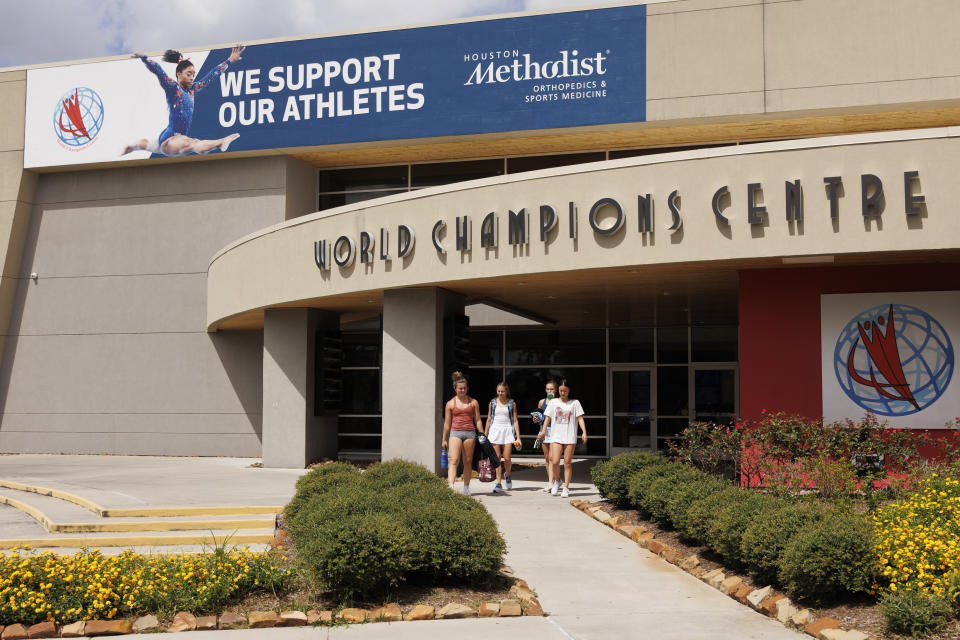Trying to make it to the Olympics? Go train with Simone Biles.
In the loneliest tier of this individual sport, the gymnasts from World Champions Centre gravitate toward one another upon arriving at competitions. They pose for photos, record dances for TikTok and wear T-shirts celebrating their “girl gang.” Originally from different parts of the country and separated by more than a decade in age, they soon will navigate the pressure-packed Olympic trials together - all because their dreams led them to the Houston suburbs, where they train alongside Simone Biles.
As Biles became the world’s best gymnast, her parents built one of the country’s best clubs. The somewhat impulsive idea stemmed from their daughter’s need for a place to train, but the gym since has grown to become the nation’s largest hub of top-tier gymnasts.
Five of the 15 women to compete at this week’s Olympic trials train at World Champions Centre, more than any other club. Apart from Biles, none of those athletes began her career in the Houston area. They uprooted their lives in the hopes that WCC, and particularly coaches Cecile and Laurent Landi, would help them reach their lofty goals.
For Biles, that means she has a place where she can escape the burden of fame and instead simply be one member of the elite crew. At practice, she’s joined by a pair of fellow Olympians in Jordan Chiles and French standout Mélanie de Jesus dos Santos. Then there are eager teenagers still climbing toward their peaks, including three who advanced to the U.S. trials.
For Biles, 27 and approaching her third Olympics, these teammates keep the sport fun.
Many of the gymnasts credit the Landis as the reason for their rapid improvement. The gym’s future is uncertain: After the Olympics, Cecile will depart to become the co-head coach at the University of Georgia, and Laurent is set to stay for just one more year.
For now, the club remains in its prime, with Biles as the headliner and her teammates as proof of its rise.
- - -
WCC started as a construction project
After Biles won her first world all-around title in 2013, her coach, Aimee Boorman, abruptly decided she wanted to coach somewhere else. Biles could have followed Boorman to a new club, but her mom, Nellie, was skeptical. Nellie met with Boorman and for the first time considered building a gym.
“That was the most stupid option,” Nellie said, “but then that option was on the table.”
The next day, Nellie drove around looking for signs that advertised land for sale. A four-acre plot near her home caught her eye. She called her husband, Ron, to deliver the news: “We’re going to build a gym.” Several days later, she signed the paperwork to complete the purchase.
The business began with six enrolled gymnasts. During one stretch as the facility was under construction, gymnasts trained in a small warehouse they nicknamed “The Shed.” To practice vault, the athletes had to begin their runs in the parking lot, Nellie said, because the building wasn’t long enough.
With Boorman still her coach, Simone practiced in the new space - a massive, state-of-the-art facility - for less than a year before the 2016 Olympics. After winning five medals in Rio de Janeiro, she took a break from the sport, and Boorman headed to a new job. In 2017, WCC didn’t have any athletes competing at elite nationals.
That fall, when Simone decided to return to training, she needed a coach. Nellie interviewed a couple of candidates, but her daughter was unimpressed. Then a USA Gymnastics staffer recommended Laurent Landi, who had coached 2016 Olympian Madison Kocian.
Laurent traveled to Spring, Tex., to talk with Nellie and Simone, and “the interview took a completely different turn,” Nellie said. Simone hadn’t engaged much in the previous conversations with coaches, but this time, Nellie saw her daughter take over the interview as she and Laurent spoke “a language that was really not mine.” They discussed difficulty scores, routine construction and ways the world’s best gymnast could get even better.
Nellie knew he had to be the pick.
Laurent made it clear that his and Cecile’s practice structure would be a change for Simone, who had been Boorman’s primary focus. The Landis led large groups at their previous gym and wanted to do the same at WCC. The Level 10 athletes, the ones aiming for college scholarships, would practice alongside the elites. Simone would be one of many.
WCC’s top group has grown so much, in large part from athletes moving there from other clubs, that the gym has more than a dozen Level 10 athletes and sent eight elites to this year’s U.S. nationals. (Apart from Biles and Chiles, all of those WCC elites joined the club within the past three years.) It’s rare for athletes of this caliber to train with their peers; at the U.S. championships, just three clubs had more than three junior or senior elites.
When Dulcy Caylor, a North Carolina native, wanted to move from her Dallas-area club to WCC, her mother’s only hesitation was about whether all the gymnasts could receive enough attention. That concern dissipated once she saw how gymnasts received a constant stream of feedback.
Laurent “can be across the gym, he can almost catch every turn, and he’ll still have some coaching to do,” said Amy Caylor, a former college soccer player. “He’s incapable of letting a bad turn go by.”
- - -
For Jordan Chiles, ‘the dopest coaches I’ve ever had’
When Biles returned to competition after the 2016 Olympics, there was no guarantee she would keep improving. Maintaining her past form would have been an accomplishment. Yet in 2018 and 2019, Biles proved she was better than before, winning major competitions by massive margins while debuting skills no other woman had attempted.
But because Biles is so uniquely talented, WCC general manager Zach Francis said outsiders probably thought: “Well, it’s Simone. Anybody could coach her.”
Chiles moved from the Pacific Northwest to train with Biles, hoping to revitalize her career. Chiles transformed into a consistent competitor, and on her way to the Tokyo Olympics in 2021, she attributed the progress to WCC and the Landis, whom she calls “the dopest coaches I’ve ever had.”
Suddenly, the perception of the club changed, Francis said: “Wow, if they can do that with this person, what could that mean for me?”
Six WCC athletes competed at the 2021 nationals, and four advanced to the Olympic trials. Around that time, Caylor was a quiet but intense 13-year-old who wanted a gym that had high expectations. She had noticed Chiles’s improvement, and her mom figured a gym owned by Biles’s parents would have a stable elite program for the foreseeable future.
Caylor tried out at WCC just before Biles, Chiles and the Landis departed for Tokyo. (Caylor was star-struck by Biles and too nervous to say hello.) After practice, Laurent asked Caylor, who had yet to compete as a junior elite, about her goals. She said she hoped to compete internationally the next season and eventually go to the Olympics and win the all-around title. While in Tokyo, Cecile emailed saying she and Laurent would like for Caylor to be at the gym when they returned.
The group continued to grow, with Joscelyn Roberson and Tiana Sumanasekera joining after the 2022 season. Roberson went from finishing 18th at U.S. nationals to earning a spot on the 2023 world championships team. She felt stagnant before the move, as though she had stopped improving, so she said, “seeing the change that I made is so insane.” Sumanasekera had struggled on bars, joking that she and Roberson gave Laurent “more than a couple heart attacks watching us.” Both gymnasts recently finished in the top 10 in the all-around at nationals to advance to the trials.
With so many gymnasts, these competitions can feel busy and mentally challenging, Cecile said, “but way better than the opposite.” Time isn’t spent with one athlete standing idly with her coaches soaking in the pressure. Instead, the WCC group is constantly in motion - giving corrections, moving mats and adjusting springboards. As athletes cycle through turns on each apparatus, the high-stakes environment resembles a familiar practice.
- - -
Showing gymnasts what’s possible
At WCC, the world’s most difficult skills have become routine. As Biles pushes the boundaries of the sport, her teammates figure they can at least attempt some of these elements, too.
“Sometimes in your mind you can think, ‘Oh my goodness, this is something huge I’ve never done before,’ but when the expectation is higher around you, it seems like it’s more possible for you to do,” said Caylor, who is competing at the trials but sees 2028 as her best Olympic opportunity.
When discussing the improvement of gymnasts, Cecile deflects.
“I don’t think it’s us,” she said. “It’s the girls.”
Most of the elites benefit from the experience of the three past Olympians in their training group. But the crew of teammates is helpful to Biles, too. She has reached a level of fame that few athletes have. But at WCC, she gets to be just one of the gymnasts.
“She doesn’t feel any different,” Nellie said. “It controls that anxiety.”
Biles’s parents remind their daughter this isn’t her gym; it’s theirs. The facility isn’t a shrine to Biles’s accomplishments. (“In my office, yes,” Nellie said, “but not out there.”) Some of Biles’s sponsors have their logos on the wall, and photos of past world championships and Olympic teams are in the lobby, but there are also more than three dozen banners recognizing athletes who have gone on to compete in college or will soon do so.
Problems come from outsiders. Nellie said tourists sometimes view WCC the same way as NASA - a must-see Houston-area attraction. The front-desk employees keep track of everyone entering. Nonmembers cannot proceed to the parents’ viewing area. They must observe from near the desk, where it’s hard to see much of the training area.
In the gym, there’s a deliberate effort to protect Biles’s sense of normalcy. At competitions, kids in the crowd constantly scream her name, but at WCC, she can train without autograph requests.
The opportunity to coach Biles prompted the Landis to table plans to open their own gym, which eventually led to the growth of WCC’s elite group. But there is a future for the club without Biles as a gymnast - whether that comes after the Paris Games or a bit later. Nellie hopes that version of the club looks similar because, she said, “Simone is just one person training here in the gym, and WCC is not Simone.”
Despite Biles’s prominence, navigating the post-Landis version of WCC could be the bigger challenge because of how much coaching drives athletes’ choices of clubs. Laurent will stay after Cecile heads to Georgia but only until next year, when their daughter finishes high school. Caylor’s mom said her daughter prods Laurent about what he’ll do next, and he jokes that he’s going to play golf.
Meanwhile, the gym carries on as usual, with more gymnasts preparing for the U.S. Olympic trials than at anywhere else. What the club becomes over the next Olympic cycle is uncertain, but what WCC is now is undeniable. Nellie Biles’s spontaneous decision gave her daughter a place to thrive and others a route toward their goals.
“The expectation,” Francis said, “is that there’s hope, that there’s opportunity.”
Related Content
He wanted to throw an Idaho town’s first Pride. Angry residents had other ideas.
The pope’s right-hand man is reshaping the church, becoming a target
How the migrant crisis tested schools 2,000 miles from the southern border

 Yahoo Sport
Yahoo Sport 












































